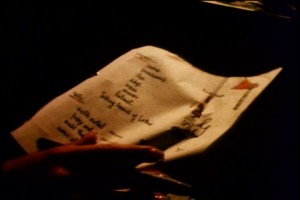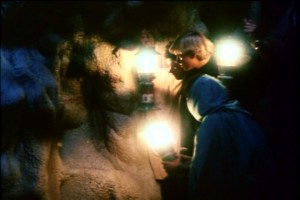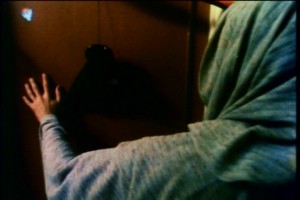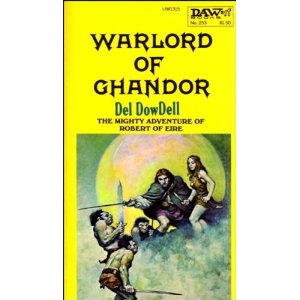I’m pretty far into my Mazes and Monsters RPG draft by now. When it comes to actually writing, I’m finding that I have to make up a lot of stuff from whole cloth. The Mazes and Monsters movie didn’t do all the work for me.
For instance, I’ve figured out the spell system, but now I actually have to fill out the spell lists. I have a handful of spell names, mostly gleaned from screencaps of Robbie’s and Kate’s character sheets.
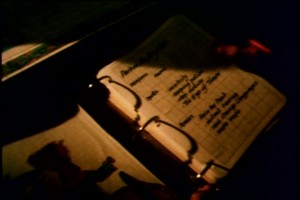
Click the picture to enlarge if you want to squint and try to read Robbie’s character sheet.
Robbie’s spells are neatly divided into “spells” and “powers”.
The spells are
invisibility
sleeping potion
stop motion
the Eye of Timor
The powers are
Raise the Dead
Instant Healing
read strange languages
and something that looks to me like
mister mister
but it can’t be, because that is an 80s band, not a spell.
Any other ideas what it could be? Misty Magic? Make Image? Make Maze? Make Movie? (Maybe this explains how Mazes and Monsters got made!)
Kate’s fighter also knows spells!
There’s a thumb in the way, but these spells look to me like
Melts Metal
Freeze Water
Make [tacos]?
Move [stuff]?
The tacos spell seems slightly implausible, because if there was a spell that did that, we’d probably see the gang eating tacos at their game sessions, to “stay in character.”
I’ve decided that spells are divided into three categories: “spells” (available to all characters), “powers” (available only to Holy Men), and “tricks” (mentioned once by Jay Jay, and thus probably available to Frenetics).
Today I’ll try to flesh out the Powers available to Holy Men. I’ll write one spell per level, from 1 to 10.
Instant Healing: Level 1 power. Restores 30 HP.
Healing is the bread and butter of the cleric-type class, so this spell should be available at level 1. 30 points of healing will probably fully heal first- or second-level characters.
Read Strange Languages: Level 2 power. You can read any written language. The spell ends when you fall asleep.
This Level 2 spell will be less popular than the level 1 healing spell, but hopefully, to compensate, Maze Controllers will put in lots of important foreign-language clues.
Holy Water: Level 3 attack power. The character is able to prepare a number of vials of Holy Water equal to their character level. Anyone can throw these vials as a normal attack. Any undead or demonic creature hit by a vial of Holy Water takes damage with a trait die.
Each Holy Water lasts until the caster falls asleep, at which point it becomes normal water.
This is the first spell I’ve written that has no basis in anything in the movie. I’ll have to do a lot of this, if I want to produce at least 30 spells, powers, and tricks.
One of the problems with low-level spellcasters is that they must hoard their spells while their fighter buddies get to swing swords all day. Inspired by the spell named “Sleeping Potion”, I decided that some attack spells might be pre-combat spells that gave the caster a limited number of pieces of ammunition.
Imagine if D&D’s Magic Missile gave first-level magic-users multiple missiles, which could be spent over the course of the day. It would give 1e magic-users more staying power over the course of the dungeon, without dropping the limited nature of 1e magic.
Full Healing: Level 4 power. Restores a character to their full Hit Point total.
A Holy Man needs a suite of successively more powerful heal spells. I’ve boosted their power relative to D&D, allowing a fourth-level character to fully heal someone, because I think Mazes and Monsters characters can’t count on getting back to town and resting whenever they want.
This spell isn’t referenced by name anywhere in the movie, but I imagine that when Robbie/Pardieux mystically lays his hand on the door of Jay Jay’s Halloween party, he thinks he is casting this spell.Seal Door: Level 5 power. Lock a single door. The door requires a RONA to open equal to the caster’s level + 3. If anyone fails this RONA, they may not try again.
Make Thunderbolts. Level 6 attack power. Creates a number of thunderbolts up to the caster’s level, which are all held in the caster’s left hand. The thunderbolts can be thrown one at a time, and follow the rules for thrown weapons. If a target is hit, it takes Lightning damage. The spell ends when the thunderbolts are used up, the caster lets go of the thunderbolts, or the caster falls asleep.
After a couple of levels of sealing doors and healing, the Holy Man should be ready for a straight-ahead attack spell around now. Lightning seems suitably divine.
Healing Potion: Level 7 power. Creates up to 5 Healing Potions. Anyone who drinks one of these potions is restored to their full Hit Point total.
Each Healing Potion lasts until the caster falls asleep, at which point it becomes normal water.
After giving full healing to Holy Men at level 4, the only way to escalate is to heal the whole party. Because the spell produces potions, the Holy Man is freed from the task of providing in-combat healing – he just hands out potions before the battle starts.
Make Maze: Level 8 power. Allows you to put a creature into the Mazed condition. You must be within throwing distance, but you don’t need to throw anything. You speak up to 20 words: the creature believes whatever you say. For instance, “The other monsters have been plotting to steal your gold!” or “The room is filled with tacos that you must eat before you can attack us!”
As with any Maze, the victim gets an immediate check to escape that Maze. The RONA to escape the Maze is equal to your level.
I decided that make maze was more likely than mister mister.
Fly: Level 9 power. The caster, or another character of his choice, is able to fly for the next hour.A flying character who takes off from a sufficiently high point (at least 1300 feet off the ground) who flies straight up for the entire hour can reach Heaven.
Robbie climbs WTC because he believes that he can fly to heaven to be reunited with his brother. I guess the extra height of the WTC makes all the difference.
Raise Dead: Level 10 power. Restores a dead person to life, with half of their maximum Hit Points. It only works for a short period after the person’s death; after that, you need to fly to Heaven to find them.

